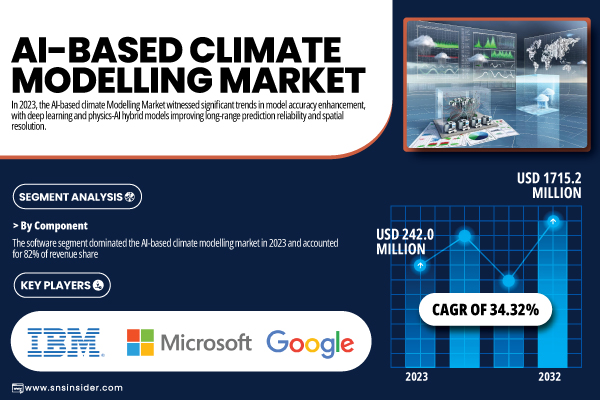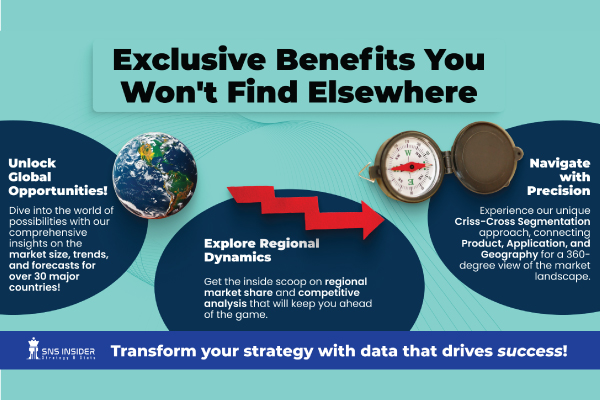Pune, June 30, 2025 (GLOBE NEWSWIRE) -- AI Based Climate Modelling Market Size Analysis:
“The SNS Insider report indicates AI Based Climate Modelling Market size was valued at USD 242.0 million in 2023 and is estimated to reach USD 1715.2 million by 2032, growing at a CAGR of 34.32% from 2024 to 2032.”
The U.S. AI-Based Climate Modelling Market was valued at USD 36.3 million in 2023 and is projected to reach USD 275.2 million by 2032, growing at a CAGR of 25.25% from 2024 to 2032. The growth is fueled by Federal investments in climate science, increasing demand for real-time weather and climate information, and technological advancements in the integration of artificial intelligence (AI) into systems utilized for public safety. The catalysts for future take-up will include regulatory requirements, energy sector forecasting needs, and uptake in the insurance and disaster risk management sectors.

Get a Sample Report of AI Based Climate Modelling Market@ https://www.snsinsider.com/sample-request/6839
Major Players Analysis Listed in this Report are:
- IBM — IBM Environmental Intelligence Suite
- Microsoft — Microsoft Planetary Computer
- Google — Google Earth Engine
- The Climate Corporation (Bayer) — Climate FieldView
- Accenture — Climate Analytics Platform
- AWS (Amazon Web Services) — Amazon Sustainability Data Initiative (ASDI)
- Tomorrow.io — Tomorrow.io Weather Engine
- Oracle — Oracle Climate Change Analytics
- Climavision — Climavision Climate Data Services
- Planet Labs — PlanetScope
- Descartes Labs — Descartes Labs Platform
- Cervest — EarthScan
- Jupiter Intelligence — ClimateScore Global
- One Concern — Domino Climate Platform
- ClimateAi — ClimateAi Analytics
AI Based Climate Modelling Market Report Scope:
| Report Attributes | Details |
| Market Size in 2023 | US$ 242.0 Million |
| Market Size by 2032 | US$ 1715.2 Million |
| CAGR | CAGR of 34.32 % From 2024 to 2032 |
| Base Year | 2023 |
| Forecast Period | 2024-2032 |
| Historical Data | 2020-2022 |
| Key Segments | • By Component (Software, Services) • By Deployment (On-premises, Cloud) • By Technology (Machine Learning, Deep Learning, Natural Language Processing (NLP), Computer Vision, Others) • By Application (Weather Forecasting, Climate Prediction, Disaster Risk Reduction, Environmental Monitoring, Others) |
| Key Growth Drivers | The rising frequency of extreme weather events drives the demand for accurate AI-based climate models for better disaster preparedness and response. |
Do you have any specific queries or need any customization research on AI Based Climate Modelling Market, Make an Enquiry Now@ https://www.snsinsider.com/enquiry/6839
By Component – Software Segment Dominated, While Services Registered Fastest Growth from 2024 to 2032
The Software segment dominated the AI-based climate modelling market in 2023 and accounted for 82% of revenue share, due to offering modelling platforms targeted to specific applications, algorithm toolkits, and simulation environments. These software solutions offer comprehensive functionality—from data ingestion, preprocessing, model training, to visualization—which are necessary for climate research and operational work.
The Services segment is experiencing the fastest growth. As organizations scale their AI, they will need more than technology partners; hence, the increasing importance of system integration and service-driven offerings, consulting, cloud deployment, customization, and model validation. Services are anticipated to grow considerably over the forecast period, driven by the increasing need for assistance and managed operations. The services market share is expected to grow considerably between 2023 and 2032, fueled by increasing complexity in climate systems and the integration of cross-industry deployment.
By Deployment – Cloud Dominated, While On Premises Registered Fastest Growth from 2024 to 2032
The Cloud segment dominated the market and accounted for 65% of revenue share in 2023, attributed to high demand for scalable, high-performance computing and processing of the large multi-source data sets. Elasticity of the cloud is very cost-effective and makes it easier & feasible for a team to run complex simulations without a big capital investment in infrastructure.
On-premises deployment is growing at a faster pace as governments and research institutions seek tight data control, low-latency processing, and compliance with local regulations. On-premises implementation attracts users dealing with sensitive meteorological and geospatial input data. By 2032, on-premises solutions will likely capture a larger share of the market as organizations balance security, performance, and regulatory needs alongside growing cloud adoption.
By Technology – Machine Learning Dominated, While Deep Learning Registered Fastest Growth from 2024 to 2032
Machine learning segment dominated the market in 2023 and accounted for a significant revenue share owing to its maturity, interpretability, and capability to augment traditional numerical models using feature-based forecasting. It is widely used in time-series prediction and anomaly detection tasks.
Deep learning is the fastest-growing technology during the forecast period, which uses neural networks to learn to recognise complicated patterns within complex data sets such as global satellite imagery and high-resolution spatial grids, and is projected to give unprecedented opportunities for the growth of the market. Deep learning models are being used more and more as computational power increases and more climate data becomes available that is labelled. Deep learning is slated to be an essential component of next-generation climate models by 2032, leading to increased fidelity in forecasts and scenario analysis.
By Application – Weather Forecasting Dominated, While Disaster Risk Reduction Registered Fastest Growth from 2024 to 2032
The Weather forecasting application leads the market in 2023 and accounted for a significant revenue share, supporting day-to-day meteorological operations and public safety with high-resolution, AI-enhanced predictive models.
Disaster risk reduction is rapidly growing as more governments utilize AI-driven modelling to simulate floods, wildfires, hurricanes, and droughts. These use cases help communities predict and prepare for crises with improved lead time. During 2024–2032, this application segment will expand significantly, bridging analytics with emergency planning systems and driving adoption in high-risk regions worldwide.

Buy an Enterprise-User PDF of AI Based Climate Modelling Market Analysis & Outlook 2024-2032@ https://www.snsinsider.com/checkout/6839
Regional Development
By North America
Due to research institutions as well as tech leaders, and federal funding, North America is the largest in the AI-based climate modelling market. The U.S. pour money into climate science and around its advanced AI platforms that serve national forecasting systems and disaster preparedness integration efforts, and remains at the top of the world till 2032.
By Asia-Pacific
The fastest growth in demand is projected to be in the Asia-Pacific, with escalating climate vulnerability, expansive deployment requirements, and greater investment in modelling demand in China, India, Japan and Southeast Asia. Above global CAGR estimates, national governments and businesses are fast leveraging AI-modelling over best practices coping with monsoons, typhoons, floods and urban heat.
About Us:
SNS Insider is one of the leading market research and consulting agencies that dominates the market research industry globally. Our company's aim is to give clients the knowledge they require in order to function in changing circumstances. In order to give you current, accurate market data, consumer insights, and opinions so that you can make decisions with confidence, we employ a variety of techniques, including surveys, video talks, and focus groups around the world.
